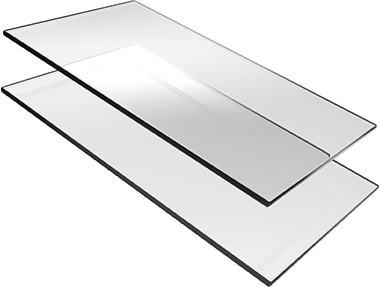 Gamma Ray Shielding Glass
Gamma Ray Shielding Glass
Pro-GR lead shielding glass was developed to protect against high radiation gamma rays used in PET scan facilities. Pro-GR is made of glass materials having a lead oxide content rate of roughly 70% that is equivalent to ultra-high lead content block glass for nuclear power facilities. Pro-GR has a radiation shielding capability higher than that of conventional LX-57B.
KEY FEATURES
|
APPLICATIONS
Ideal for use in PET Scan facilities.
Statistics
Shielding Performance Against Gamma Rays
In calculating the shielding performance of Pro-GR against 0.511 MeV gamma rays, the Monte Carlo simulation is used to calculate the build-up factor of Pro-GR glass, and calculates the effective dose transmission factor in accordance with the Manual for Shielding Calculation of Radiation Facilities, 2000 (issued by the Nuclear Safety Technology Center). In calculating the lead equivalent of Pro-GR, the thickness of Pro-GR was designed so that the effective dose transmission factor is equivalent to the effective dose transmission factor of lead calculated by taking the build-up factor into account as shown in the following table.
Effective Dose Transmission Factor Of Lead For 0.511 Mev Gamma Rays And Thickness Of Pro-GR Corresponding To Each Thickness Of Lead
| LEAD | PRO-GR | ||
| Thickness | Effective Dose Transmission Factor | Pro-GR Thickness Recommended (Corresponds to Lead Effective Dose Transmission) |
Recommended Product |
| 5.0 mm [1.21] |
52.6 | 14.2 mm [1.33] |
Pro-GR 14.7 mm |
| 7.5 mm [1.25] |
36.0 | 21.3 mm [1.45] |
Pro-GR 21.8 mm |
|
Note: Numbers in brackets [ ] are reference values and are the build-up factors of Lead and Pro-GR. In the case of 0.2 MeV X-Rays, the effective dose transmission factor of lead at 5mm thickness is 0.48% and 7.5mm is .0.033% |
|||
Performance Data
| Pro-GR 14.7 | Pro-GR 21.8 | |
|---|---|---|
| Thickness (mm) | 14.7 | 21.8 |
| Effective Dose Transmission Factor* (%) | 52.6 | 36.0 |
| Lead Equivalent (mmPb) | 5.0 | 7.5 |
| Minimum Size (mm) | 42” x 60” (1000 mm x 1500mm) | 42” x 60” (1000 mm x 1500mm) |
| Specific Gravity | Min. 5.20 | Min. 5.20 |
| Knoop Hardness | 320 | 320 |
| Visible Light Transmission | 83% | 83% |



